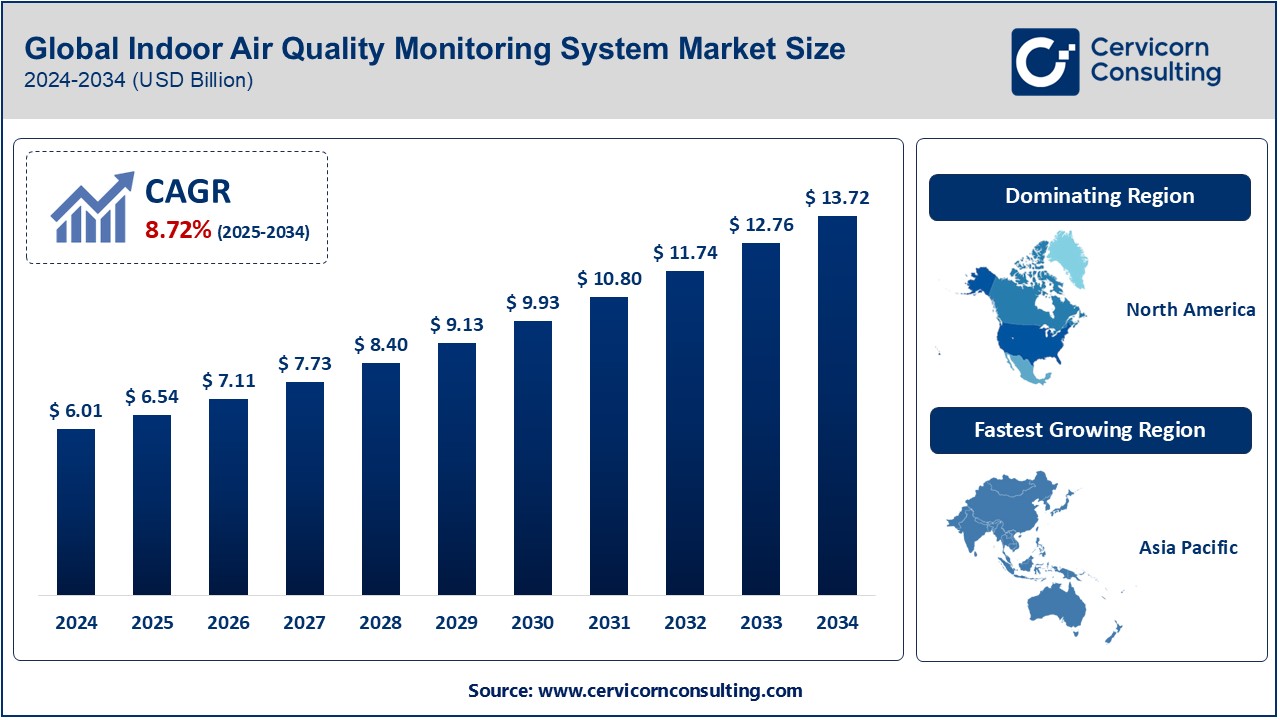Indoor Air Quality Monitoring System Market Growth, Trends, Key Players, and Regional Insights (2024-2034)
Indoor Air Quality Monitoring System Market Growth
The global indoor air quality monitoring system market was worth USD 6.01 billion in 2024 and is anticipated to expand to around USD 13.72 billion by 2034, registering a compound annual growth rate (CAGR) of 8.72% from 2025 to 2034.
The indoor air quality monitoring system market is experiencing substantial growth due to a combination of factors such as increasing awareness about the health impacts of poor indoor air quality, rising industrialization, urbanization, and stringent government regulations regarding environmental standards. As people become more conscious of the effects of air pollution on health, both at home and in workplaces, there is a heightened demand for systems that can monitor and improve air quality. The growth of smart homes, commercial buildings, and industrial facilities also drives demand for advanced air quality monitoring technologies.
Additionally, technological advancements in sensors, IoT integration, and artificial intelligence (AI) are making IAQ monitoring systems more efficient, accessible, and cost-effective. Regulatory frameworks in regions such as North America, Europe, and Asia-Pacific are pushing businesses and households to adopt IAQ monitoring solutions to comply with air quality standards. Furthermore, the COVID-19 pandemic has heightened the focus on air quality due to its direct link to respiratory health, adding to the growth trajectory of the IAQ monitoring system market.
What is the Indoor Air Quality Monitoring System Market?
The indoor air quality monitoring system market consists of products and technologies designed to assess the quality of air within enclosed spaces. These systems are crucial for detecting pollutants and harmful gases such as carbon dioxide (CO2), particulate matter (PM), volatile organic compounds (VOCs), nitrogen dioxide (NO2), and ozone (O3). IAQ monitoring solutions typically include sensors, detectors, data loggers, and air quality meters that can provide real-time data on air quality parameters. These systems are integral in residential, commercial, industrial, and institutional settings, ensuring that air quality is maintained at safe levels for inhabitants. The systems can be standalone or integrated into larger building management systems (BMS), offering convenience and efficiency in managing indoor environments.
Why is Indoor Air Quality Monitoring System Important?
Indoor air quality plays a significant role in the health and well-being of individuals. Poor indoor air quality can lead to a range of health problems, including respiratory diseases, allergies, headaches, fatigue, and even more serious conditions like cardiovascular diseases and cancer. In workplaces, poor IAQ can result in decreased productivity and employee absenteeism due to illness. For buildings with sensitive environments, such as hospitals and laboratories, maintaining optimal air quality is critical to ensure the safety and comfort of both staff and patients. By providing continuous, real-time monitoring, IAQ systems help identify and mitigate harmful air quality issues, leading to improved health outcomes, higher productivity, and reduced healthcare costs. Additionally, businesses and public institutions that invest in air quality monitoring systems can meet regulatory compliance standards and enhance their reputation as responsible organizations committed to the welfare of their occupants.
Get a Free Sample: https://www.cervicornconsulting.com/sample/2481
Company, Specialization, Key Focus Areas, Notable Features, 2023 Revenue (approx.), Market Share (approx.), Global Presence – Indoor Air Quality Monitoring System Market Top Companies
- 3M
- Specialization: 3M is a global leader in the manufacturing of innovative solutions for air quality monitoring, including sensors and IAQ measurement tools.
- Key Focus Areas: Environmental safety, air quality control, and compliance with regulatory standards.
- Notable Features: 3M’s IAQ solutions are known for their precision in detecting particulate matter and gas emissions. They integrate seamlessly with existing building management systems.
- 2023 Revenue (approx.): $45.2 billion (entire company revenue).
- Market Share (approx.): 10-12% in the global IAQ market.
- Global Presence: 3M operates in over 70 countries globally, with a significant presence in North America, Europe, and Asia-Pacific.
- General Electric (GE)
- Specialization: GE offers smart building solutions, including advanced IAQ monitoring systems integrated with its digital building technology.
- Key Focus Areas: Sustainability, energy efficiency, and integrating IAQ systems into broader smart infrastructure.
- Notable Features: GE’s IAQ monitoring solutions are known for their integration with IoT and building automation systems, allowing real-time data analysis and predictive maintenance.
- 2023 Revenue (approx.): $20.1 billion (for GE HealthCare and other segments).
- Market Share (approx.): 6-8%.
- Global Presence: GE has a widespread presence in over 180 countries, particularly strong in North America, Europe, and Asia.
- HORIBA Scientific
- Specialization: HORIBA is a leader in analytical and monitoring equipment, including systems for air quality monitoring in scientific and industrial applications.
- Key Focus Areas: Emissions testing, environmental monitoring, and air quality assessment in laboratory settings.
- Notable Features: Known for precision air quality sensors that cater to both regulatory compliance and scientific research.
- 2023 Revenue (approx.): $5 billion (entire company revenue).
- Market Share (approx.): 4-5%.
- Global Presence: HORIBA operates across the globe, with a strong presence in Japan, Europe, and North America.
- Aeroqual
- Specialization: Aeroqual specializes in high-accuracy air quality monitoring solutions for both indoor and outdoor applications.
- Key Focus Areas: Pollution measurement, VOC detection, particulate monitoring, and integration with environmental sensors.
- Notable Features: Aeroqual is known for its portable, easy-to-use IAQ monitors that provide accurate, real-time data for both residential and commercial use.
- 2023 Revenue (approx.): $50 million.
- Market Share (approx.): 3-4%.
- Global Presence: Aeroqual has a strong presence in New Zealand, the United States, and Europe.
- Emerson Electric Co.
- Specialization: Emerson manufactures a wide range of IAQ monitoring instruments, including temperature, humidity, CO2, and particulate sensors for residential and commercial buildings.
- Key Focus Areas: Automation, energy efficiency, and environmental control in buildings and industrial facilities.
- Notable Features: Emerson’s IAQ solutions are recognized for their energy-saving capabilities and integration with building automation systems.
- 2023 Revenue (approx.): $26.3 billion.
- Market Share (approx.): 5-6%.
- Global Presence: Emerson operates globally with significant market share in North America, Europe, and Asia.
Leading Trends and Their Impact
Several trends are shaping the growth and development of the IAQ monitoring system market. One of the primary trends is the integration of IoT and AI with IAQ monitoring systems. This allows for real-time data collection, predictive analytics, and automated adjustments to improve indoor air quality. These systems can be linked to HVAC systems, lighting, and other building controls to optimize air quality while reducing energy consumption. Another key trend is the growing demand for portable and consumer-grade air quality monitoring devices. This trend is driven by increasing consumer awareness about the impact of air quality on health, particularly in urban areas.
Additionally, the rise of smart homes and smart offices, equipped with interconnected devices, is boosting the demand for IAQ monitoring systems that can seamlessly integrate with other smart systems. Finally, there is an increasing focus on sustainability and green building certifications, where IAQ monitoring plays a crucial role in achieving energy efficiency and environmental goals.
Successful Examples of Indoor Air Quality Monitoring Systems Around the World
Several successful examples demonstrate the effectiveness of IAQ monitoring systems in improving health outcomes and operational efficiency. In Singapore, the government has implemented smart city solutions that include widespread IAQ monitoring to improve public health, especially in public transportation systems and public buildings. In the United States, the Green Building Council has endorsed IAQ monitoring as part of the LEED (Leadership in Energy and Environmental Design) certification process, ensuring that buildings meet high environmental standards. In commercial spaces, companies like Google and Apple have adopted advanced IAQ monitoring systems to ensure employee well-being, integrating these systems with their smart building technologies. These examples highlight the importance of IAQ monitoring in various sectors, contributing to better air quality, health, and sustainability goals.
Regional Analysis Including Government Initiatives and Policies Shaping the Market
The indoor air quality monitoring system market is experiencing varied growth across regions, driven by local regulations, government policies, and regional awareness of air quality issues.
- North America: In North America, particularly in the United States and Canada, stringent regulations and standards related to air quality are driving market growth. The U.S. Environmental Protection Agency (EPA) has implemented regulations that push industries to monitor and control indoor air pollution. Many states have also introduced their own building codes, demanding air quality testing and monitoring systems.
- Europe: The European Union (EU) has set clear standards for air quality monitoring, not just for outdoor environments but also for indoor spaces. EU countries like Germany, France, and the UK have pushed for greater investment in IAQ monitoring systems, especially in workplaces and schools, to ensure compliance with health and safety standards. The European Green Deal has also made sustainability a top priority, encouraging the adoption of IAQ monitoring in buildings.
- Asia-Pacific: The Asia-Pacific region is witnessing rapid urbanization, with many new residential and commercial buildings being constructed in countries like China and India. This has led to an increased need for IAQ monitoring systems. Government policies in these countries are becoming more stringent with respect to air quality standards, further propelling the demand for advanced monitoring systems. In Japan, indoor air quality has been a concern for decades, and regulatory frameworks ensure that commercial and residential buildings maintain optimal air quality.
- Middle East & Africa: Countries in the Middle East, particularly those in the Gulf Cooperation Council (GCC), are focusing on sustainable development and energy-efficient building systems. As part of this vision, IAQ monitoring systems are becoming essential in commercial spaces and residential buildings to meet both environmental and health standards.
To Get Detailed Overview, Contact Us: https://www.cervicornconsulting.com/contact-us
Read Report: Digital Transformation Market to Hit USD 13.75 Trillion by 2033



